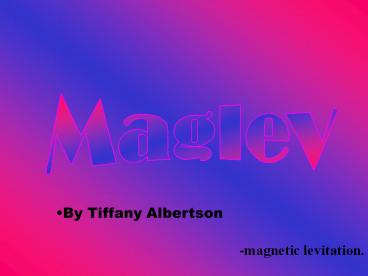Maglev - PowerPoint PPT Presentation
1 / 11
Title: Maglev
1
Maglev
- By Tiffany Albertson
-magnetic levitation.
2
Maglev trains
- A few countries are using powerful electromagnets
to develop high-speed trains, called maglev
trains.
- Traveling at speeds of up to 310 mph (500 kph),
maglev trains could begin connecting distant
cities in a few years.
3
How it works.
- A maglev train floats about 10mm above the guide
way on a magnetic field.
- It is propelled by the guide way itself rather
than an onboard engine by changing magnetic
fields.
4
How it works cont
- Once the train is pulled into the next section
the magnetism switches so that the train is
pulled on again.
- The Electro-magnets run the length of the guide
way.
5
Advantages?
- Well it sounds high-tech, a floating train, they
do offer certain benefits over conventional steel
rail on steel wheel railways.
- The primary advantage is maintenance.
6
Advantages? Cont
- Because the train floats along there is no
contact with the ground and therefore no need for
any moving parts.
- As a result there are no components that would
wear out.
7
Advantages? Cont
- In theory, this means, trains and track would
need no maintenance at all. - Note that there is still air resistance.
- The second advantage is that because maglev
trains float, there is no friction.
8
Advantages? Cont
- A third advantage is less noise.
- Because there are no wheels running along there
is no wheel noise.
- However noise due to air disturbance still occurs
while the train is in motion.
9
Advantages? Cont
- The final advantage is speed.
- As a result of the three previous listed it is
more viable for maglev trains to travel extremely
fast
- i.e. 500km/h or 300mph.
- Although this is possible with conventional rail
it is not economically viable.
10
Advantages? Cont
- Ah-ha tricked ya! There is one more advantage.
- Another advantage is that the guide way can be
made a lot thicker in places.
- E.g. after stations and going uphill, Which would
mean a maglev could get up to 300kmh (186mph) in
only 5km where currently takes 18km.
11
Advantages? Cont
- Also greater gradients would be applicable.
- O.k I mean it now this was the last one.
- The end































